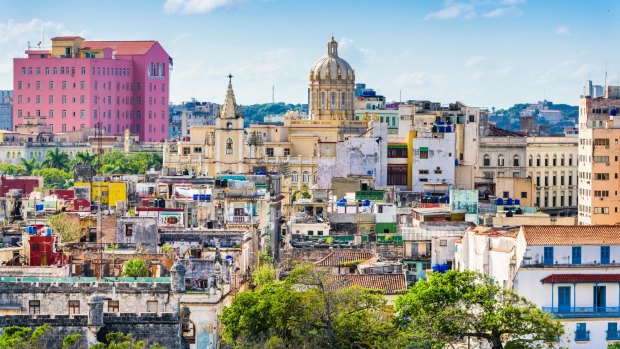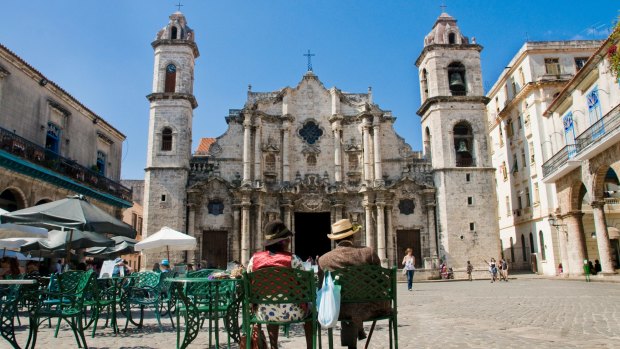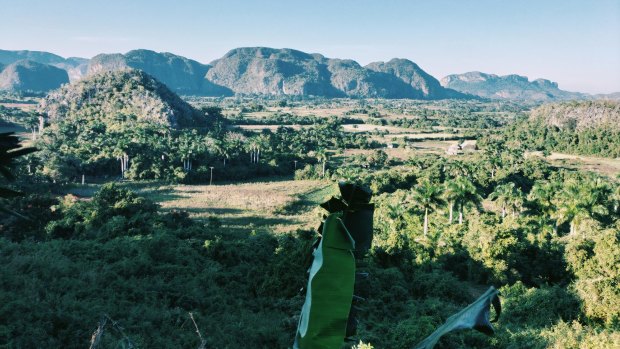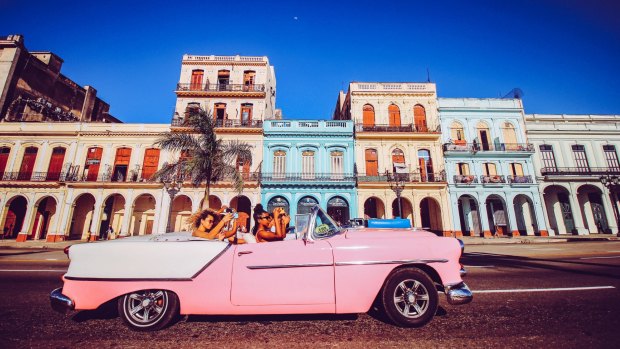This was published 2 years ago
Cuba travel guide: Tourism is making a comeback in this amazing country

You won't find many tourists in Havana right now, but that's set to change.Credit: iStock
Even though I'm here an hour on the traditionally sober side of midday, there's already a throng of American tourists at Ernest Hemingway's favourite bar in Old Havana, La Bodeguita del Medio.
They're here for the bar's mojito cocktails (Cuban rum, mint, sugar, lime and club soda) because La Bodeguita del Medio is where the drink was allegedly invented, and because this is where Hemingway allegedly came to drink them.
One American tour group is seated already at the bar while another group drinks their mojitos outside. A third gathering waits impatiently on the sidelines. Buskers play Buena Vista Social Club tunes with their hats out for US dollars and someone is selling the Che Guevara souvenir T-shirts you knew you'd find in Cuba.
What's unusual about this very typical American tourist scene in Cuba is that it's not absolutely atypical.
This is the first crowd of American tourists – or any international tourists at all - I've seen in Cuba since I got here a week ago and it's a sign of things to come. The Americans are coming (back).
Pre-COVID (and pre-Trump) cruise ships full of Americans filled its harbour, and tourist coaches dwarfed Old Havana's narrow streets. Now, the moment I leave La Bodeguita del Medio behind, I'm almost the only foreign tourist in town.
In 2008, US President-elect Barack Obama promised to create a new beginning with Cuba. In the final two years of his presidency, the country became a top attraction for US tourists, and travellers from across the world.
Cruise ships filled Havana's harbours, hundreds of commercial planes arrived at its international airports; by 2015, the number of US tourists jumped 77 per cent against 2014's tally; a year later that number increased another 74 per cent.
In March 2016, President Obama became the first sitting president to visit Havana since 1928, as 500,000 Cubans watched the Rolling Stones play a free concert to mark the occasion.
And then everything changed. President Trump derided Obama's changes as "a shameful accommodation to the demands of its (Cuba's) tyrants".
He and his administration drafted sanctions to tighten rules on travel, which along with the crippling effects of the COVID-19 pandemic, reduced tourism numbers by as much as 90 per cent. Cuba suffered its most acute exodus of citizens since the Cold War, most of them leaving illegally, into the US.
But times are changing. The Biden administration is easing restrictions on travel, with more commercial flights available each month while strict COVID-19 restrictions have been dumped.
This, then, explains those surprising advance parties American tourists back at La Bodeguita del Medio.
As Cuba re-emerges as a destination, and with the Americans set to return in conspicuous numbers, now really is the time to experience Cuba for yourself, providing a rare opportunity for proper immersion into Cuban communities.
Certainly, there were few (if any) foreigners where I was travelling, as I embarked on a new six-day tour of Cuba which uses only local guides and drivers, with accommodation at home-stays (casas) run by local families, far from hotels or resorts. But let's start back at the beginning of my Cuban odyssey.
DAYS ONE AND TWO
Old Havana

Credit: Simply Cuba Tours
The only queues I see on arrival in Old Havana aren't outside the city's 17th-century baroque and neoclassical churches, they're up and down the footpath outside the Spanish Embassy.
Hundreds of Cubans with Spanish ancestry are dressed to the nines, pleading for a visa to get out of the city.
Life may be tough here, but visitors sure wouldn't know it. Old Havana looks as surreal as a film set. In reality, it's a UNESCO World Heritage site encircled by 500-year-old forts and the Atlantic Ocean.
Its buildings are of the primary and secondary colour variety – vibrant splashes of oranges, blues, pinks, yellows and greens – while the emblematic cars on its cobble-stoned streets mostly come out of 1950s America: shiny steel Pontiacs, Chevrolets, Buicks and Studebakers which pre-date Cuba's 1959 Marxist revolution.
"They say we have the best mechanics on Earth," says Yoanis Blanco Santos, co-founder and lead guide of the Australian-originated Simply Cuba Tours. "Imagine if your country had no new cars for 60 years."
But what I notice most is that locals live their lives so close to the street, inside regal but crumbling apartment buildings. I'm a voyeur in Havana, merely by walking its streets.
My casa is in the heart of the Old Town, within a centuries-old apartment block. I climb a staircase to a rooftop which looks out across the city, to a lightning storm brewing above the Strait of Florida.
Old Havana is a walking city, its tight, cobbled streets make driving difficult with life playing out like some sort of theatre you can only properly experience from the closest of quarters.
There's even a five-piece band playing on my street corner. I watch them, then throw two US dollars into the hat they leave out for tips. "You gave them what a doctor earns in two weeks," Santos says.
Although, post the worst of the pandemic and post-Trump, there are few tourists on the streets, there's a party atmosphere about Old Havana. Locals drink and dine at al fresco restaurants, music blares from every apartment and every tree is lit.
It's as if the residents of Havana celebrate electricity because they know they're the only place in Cuba assured of having it.
Santos walks me through 500-year-old plazas, fortresses and palaces (there are more than 1000 buildings of historical importance here) to a harbour where locals fish beneath palm trees which swish with the sea breeze.
"There used to be at least two cruise ships a day," Santos points at an empty space in the harbour. "Everything was busy here, cars to pick up tourists, buses, all the hawkers, you should've seen it."
Dinner tonight is in a tight laneway of al fresco restaurants and the food's delicious. I order ropa vieja, shredded beef slow cooked in tomatoes, onions, peppers, garlic and wine served with sweet plantain – Cuban food isn't simply rice and beans, it's a mix of traditional Taino food, with Caribbean, African and Spanish influences.
But it's the flavours of the street life that keep engaging me, since locals in Old Havana don't watch TV, or go to bed early with a book. The town buzzes with a blur of frenzied movement. Later as I attempt to sleep, the synthesis of Cuban music keeps me up till the early hours (and I don't mind at all).
DAYS TWO AND THREE
Havana to Vinales

Credit: Simply Cuba Tours
Breakfast is served on my rooftop by the family who own my casa and who all somehow manage to play a role in the preparation of my meal. I sit at a table looking out to Havana below. (Good luck finding a latte in Cuba but the brewed coffee is strong and not so bitter).
I follow Santos around the old town for the morning then our driver, Julio, picks us up and we hit the highway west. It takes barely 10 minutes to leave all the traffic behind. Santos is hungry and suggests we sample a traditional pork sandwich cooked by the side of the road.
Music blares from under a hot tin shed, as local workers line up beside me waiting for pork cooked over coals. Returning to his medico analogy, Santos says: "These guys can make more money in a day than a doctor in a year with the average salary in Cuba being about $US35 per month.
Our road trip becomes more like a mobile picnic as we stop and eat from vendors along the roadway - local treats mostly, like plantain balls and yuca chips. The only cars I can see bellow black smoke but as we drive further into the countryside they are replaced by horse-drawn carts and old tractors.
Green mountains appear, beyond vast tracts of farmland – this must be what a relatively nearby Florida looked like before Disney World and all those high-rises emerged (the state is barely 160 kilometres north).
Two hours west of Havana, we enter the Vinales Valley, arguably the best - if that's an appropriate word - tobacco-growing region on Earth.
A World Heritage site, the valley's made up of karsts encircled by mountains and dome-like limestone outcrops that rise as high as 300 metres, called mogotes. The main street is a colourful collection of colonial-era timber houses.
"This is the real Cuba," Santos says. Once western Cuba's most popular tourist destination, today I'm one of only a handful of travellers here.
Where backpackers once congregated to drink cheap beer in an old square, now, more authentically perhaps, there are old men who play dominoes under palm trees, beside an old Catholic church.
I'm taken on foot down a series of muddy tracks to a tobacco farm run by an 81-year-old tobacco farmer (guajiro) who uses an oxen and plough to work his crop.
His wife brews up a pot of strong coffee in a farmhouse built from corrugated iron, and we sit and sip as we smoke cigars till my head feels dizzy.
On the way back to my casa behind town, we slip into a concrete dug-out crowded with local men behind a baseball field to watch Vinales play its neighbour.
At the bottom of the ninth innings, in what is the national sport along with football, Vinales' baker, Jorge, hits a home run that steals victory for the home team, 5-4, and I'm caught in the celebrations. "There are no museums on this tour," Santos says as we walk home after, still buzzing.
I'd sooner watch the storms play themselves out over the mountains from my sillon (rocking chair) on the porch outside my casa, but I have salsa to learn. Santos returns to the casa to inform me my teacher, unexpectedly, has left Cuba in an attempt to enter the US.
"We always have to have a contingency plan in Cuba, " he says. "We have a saying, everything can be solved … except death."
We eat dinner at a restaurant, Casa de Confianza, built on the side of a mountain within an organic farm where pigs, goats and horses roam. We dine al fresco on a wrap-around porch beside a terraced garden looking out across 500-metre-high mountains as the sun sets.
A blackout changes my plans to drink at a bar on the way home. I like the darkness anyway, outside on my porch on my sillon watching the Milky Way with my casa host, Ernesto, who speaks just enough English for me to understand how hard life has been for casa hosts without any tourists. We mostly sit in silence in the dark and watch stars shoot across the night sky.
DAYS FOUR AND FIVE
Vinales to Soroa

Credit: Simply Cuba Tours
Yesterday was spent exploring caves, climbing mountains, hiking forests and talking to locals in sleepy paladars (family-run restaurants). Simply Cuba Tours run tours for a minimum of two guests, so it feels like I'm travelling as part of some sort of odd family unit (my driver knows not a word of English), not a tourist group.
It therefore doesn't seem unusual when Santos takes me to meet his mother on the way today to Soroa, 100 kilometres east, who tells me about the days it was forbidden to play the Beatles in Cuba.
Soroa is nestled in mountains near Cuba's north coast, part of a UNESCO Biosphere Reserve locals dub the "rainbow of Cuba". I share a casa terraced up a hill in a forest with chickens, pigs, goats and a local family, who cook me copious amounts of my former co-tenants.
I'm here on a Sunday so I share this green oasis with families out for a day trip from Havana who ride past in trays pulled by tractors, and in prehistoric buses that labour up impossibly steep hills.
The whole valley smells of jasmine as I hike my way through forests of orchids, bromeliads and butterflies to waterfalls where local families cool down in swimming holes below the cascades.
In the evening, I sit out on my patio with a Cuban Cristal-brand beer, searching for animal shapes in the pink clouds, discussing Cuban politics with my host who likes listening to Bryan Adams sing in Spanish.
Mostly in Soroa I just like to observe Cuban life; the tiny children in school uniforms waiting at bus stops along the roadway, farmers tending fields with ploughs pulled by bullocks, workers hitch-hiking to factories and offices. That there are no other foreigners here makes me all the more interesting to them.
DAY SIX
Soroa to Havana

Credit: Simply Cuba Tours
Before I know it, I'm back to the bright lights of Havana where my itinerary permits me one cliched, though glorious, tourist activity (not counting the Hemingway bar): a ride through Old Havana in a gleaming, pink steel 1949 Bel Air Style Line Deluxe convertible.
For 50 years Cuba imported the best cars America could produce. After its 1959 Revolution, President Castro banned their importation, so Old Havana has been a living museum for classic American cars ever since (there are about 60,000 classic American cars in Cuba, half of which were made in the 1950s).
The late afternoon sun shines brightly on my face and Cuban music blares through the stereo as we cruise Old Havana's narrow streets, past murals of Guevara and statues of Castro to a four-lane esplanade beside the Atlantic.
Florida lies barely 300 kilometres north across that water (on my flight out tomorrow, I'll be alarmed to see the US below me barely 15 minutes after take-off) but Cuba, for now at least, feels about as foreign a place as could possibly be.
Craig Tansley travelled courtesy of Simply Cuba Tours.
FIVE MORE THINGS YOU SHOULD KNOW ABOUT CUBA
TAKE NOTE
Cash is king so only take US dollars or Euros with you. Many bank cards – including Westpac, Bank Of Melbourne, Citibank - and any American credit cards notoriously won't work here.
GO BYO
Pack all essentials as items like shampoo, soap and basic medicinal products aren't freely available in Cuba. Also consider bringing extras, like pens, pencils, medicines, clothes, to leave with your hosts.
MAKING CONNECTIONS
Cuba didn't get access to the Internet until 1996. Some accommodations do offer Wi-Fi but it's often unreliable and you can't roam here. You can pre-order a SIM card and pick it up at Jose Marti Airport. You'll also get a data pack.
STAYING SAFE
Exercise normal personal security precautions but travelling in Cuba is generally safe. Cubans face heavy penalties for any infringement against travellers and violence is punishable with long jail sentences.
BE AWARE
Since ex-President Trump declared Cuba a supporter of terrorism in January 2021, anyone who travels there will no longer be eligible to travel to the US under the convenient ESTA (Electronic System for Travel Authorisation) waiver scheme.
THE DETAILS
TOUR
Simply Cuba Tours offer a six-day, five-night Wonders Of Western Cuba tour from €1875 ($2918) a person for group sizes between two and eight. The price includes a local guide, driver, accommodation at casas and most meals and activities. Other tours are also available. See simplycubatours.com
ENTER
You need to obtain a Cuban Tourist Card before travel. If travelling through Canada it may be included in your ticket price, if travelling through Mexico or Panama, it can be obtained at the airport before travel. Or arrange via the Cuban Embassy in Australia or through a travel agent, or order online. See easytourist.com
FLY
The quickest route to Cuba goes through Los Angeles and Miami, American Airlines (aa.com) fly multiple times daily from Miami. Delta Airlines (delta.com) will fly Miami to Havana twice daily from April 10. (You'll need a tourist visa for the US, as an ESTA won't be valid). O fly LA then Mexico or Panama City with American Airlines. You'll also be able to fly via Santiago later in 2023. Also consider adding Cuba to a European holiday and fly via Frankfurt or Paris, or via Qatar or Abu Dhabi.
STAY
Every hotel in Cuba is at least 51 per cent Government-owned (so if travelling from the US, you won't be able to stay at one). Some of the finest five-star hotels in Havana include Gran Hotel Manzana (kempinski.com) and Hotel Residencia Santa Clara (residenciahotels.com). However, the best options for most foreign visitors are family-run casas.
MORE
Sign up for the Traveller Deals newsletter
Get exclusive travel deals delivered straight to your inbox. Sign up now.